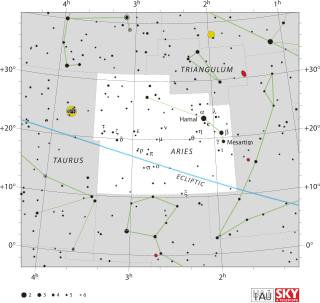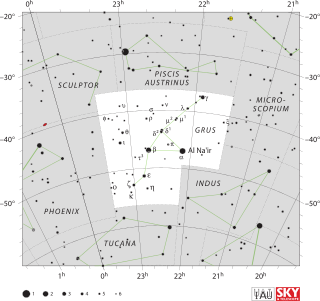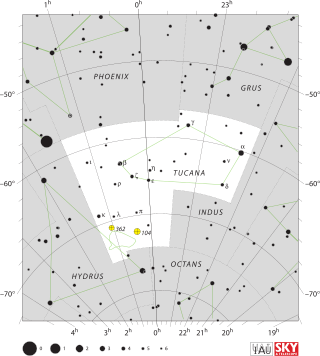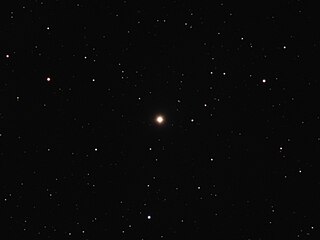
Aries is one of the constellations of the zodiac. It is located in the Northern celestial hemisphere between Pisces to the west and Taurus to the east. The name Aries is Latin for ram. Its old astronomical symbol is (♈︎). It is one of the 48 constellations described by the 2nd century astronomer Ptolemy, and remains one of the 88 modern constellations. It is a mid-sized constellation ranking 39th in overall size, with an area of 441 square degrees.

Corona Australis is a constellation in the Southern Celestial Hemisphere. Its Latin name means "southern crown", and it is the southern counterpart of Corona Borealis, the northern crown. It is one of the 48 constellations listed by the 2nd-century astronomer Ptolemy, and it remains one of the 88 modern constellations. The Ancient Greeks saw Corona Australis as a wreath rather than a crown and associated it with Sagittarius or Centaurus. Other cultures have likened the pattern to a turtle, ostrich nest, a tent, or even a hut belonging to a rock hyrax.

Grus is a constellation in the southern sky. Its name is Latin for the crane, a type of bird. It is one of twelve constellations conceived by Petrus Plancius from the observations of Pieter Dirkszoon Keyser and Frederick de Houtman. Grus first appeared on a 35-centimetre-diameter (14-inch) celestial globe published in 1598 in Amsterdam by Plancius and Jodocus Hondius and was depicted in Johann Bayer's star atlas Uranometria of 1603. French explorer and astronomer Nicolas-Louis de Lacaille gave Bayer designations to its stars in 1756, some of which had been previously considered part of the neighbouring constellation Piscis Austrinus. The constellations Grus, Pavo, Phoenix and Tucana are collectively known as the "Southern Birds".

Hydrus is a small constellation in the deep southern sky. It was one of twelve constellations created by Petrus Plancius from the observations of Pieter Dirkszoon Keyser and Frederick de Houtman and it first appeared on a 35-cm (14 in) diameter celestial globe published in late 1597 in Amsterdam by Plancius and Jodocus Hondius. The first depiction of this constellation in a celestial atlas was in Johann Bayer's Uranometria of 1603. The French explorer and astronomer Nicolas Louis de Lacaille charted the brighter stars and gave their Bayer designations in 1756. Its name means "male water snake", as opposed to Hydra, a much larger constellation that represents a female water snake. It remains below the horizon for most Northern Hemisphere observers.

Triangulum is a small constellation in the northern sky. Its name is Latin for "triangle", derived from its three brightest stars, which form a long and narrow triangle. Known to the ancient Babylonians and Greeks, Triangulum was one of the 48 constellations listed by the 2nd century astronomer Ptolemy. The celestial cartographers Johann Bayer and John Flamsteed catalogued the constellation's stars, giving six of them Bayer designations.

Tucana is a constellation of stars in the southern sky, named after the toucan, a South American bird. It is one of twelve constellations conceived in the late sixteenth century by Petrus Plancius from the observations of Pieter Dirkszoon Keyser and Frederick de Houtman. Tucana first appeared on a 35-centimetre-diameter (14 in) celestial globe published in 1598 in Amsterdam by Plancius and Jodocus Hondius and was depicted in Johann Bayer's star atlas Uranometria of 1603. French explorer and astronomer Nicolas Louis de Lacaille gave its stars Bayer designations in 1756. The constellations Tucana, Grus, Phoenix and Pavo are collectively known as the "Southern Birds".

Triangulum Australe is a small constellation in the far Southern Celestial Hemisphere. Its name is Latin for "the southern triangle", which distinguishes it from Triangulum in the northern sky and is derived from the acute, almost equilateral pattern of its three brightest stars. It was first depicted on a celestial globe as Triangulus Antarcticus by Petrus Plancius in 1589, and later with more accuracy and its current name by Johann Bayer in his 1603 Uranometria. The French explorer and astronomer Nicolas Louis de Lacaille charted and gave the brighter stars their Bayer designations in 1756.

Telescopium is a minor constellation in the southern celestial hemisphere, one of twelve named in the 18th century by French astronomer Nicolas-Louis de Lacaille and one of several depicting scientific instruments. Its name is a Latinized form of the Greek word for telescope. Telescopium was later much reduced in size by Francis Baily and Benjamin Gould.

Perseus is a constellation in the northern sky, named after the Greek mythological hero Perseus. It is one of the 48 ancient constellations listed by the 2nd-century astronomer Ptolemy, and among the 88 modern constellations defined by the International Astronomical Union (IAU). It is located near several other constellations named after ancient Greek legends surrounding Perseus, including Andromeda to the west and Cassiopeia to the north. Perseus is also bordered by Aries and Taurus to the south, Auriga to the east, Camelopardalis to the north, and Triangulum to the west. Some star atlases during the early 19th century also depicted Perseus holding the disembodied head of Medusa, whose asterism was named together as Perseus et Caput Medusae; however, this never came into popular usage.

Musca is a small constellation in the deep southern sky. It was one of 12 constellations created by Petrus Plancius from the observations of Pieter Dirkszoon Keyser and Frederick de Houtman, and it first appeared on a celestial globe 35 cm (14 in) in diameter published in 1597 in Amsterdam by Plancius and Jodocus Hondius. The first depiction of this constellation in a celestial atlas was in Johann Bayer's Uranometria of 1603. It was also known as Apis for 200 years. Musca remains below the horizon for most Northern Hemisphere observers.

Leo Minor is a small and faint constellation in the northern celestial hemisphere. Its name is Latin for "the smaller lion", in contrast to Leo, the larger lion. It lies between the larger and more recognizable Ursa Major to the north and Leo to the south. Leo Minor was not regarded as a separate constellation by classical astronomers; it was designated by Johannes Hevelius in 1687.

Pavo is a constellation in the southern sky whose name is Latin for 'peacock'. Pavo first appeared on a 35-cm (14 in) diameter celestial globe published in 1598 in Amsterdam by Petrus Plancius and Jodocus Hondius and was depicted in Johann Bayer's star atlas Uranometria of 1603, and was likely conceived by Plancius from the observations of Pieter Dirkszoon Keyser and Frederick de Houtman. French explorer and astronomer Nicolas-Louis de Lacaille gave its stars Bayer designations in 1756. The constellations Pavo, Grus, Phoenix and Tucana are collectively known as the "Southern Birds".

41 Arietis is a triple star system in the northern constellation of Aries. With an apparent visual magnitude of 3.63, this system is readily visible to the naked eye. It has an annual parallax shift of 19.69 mas, which indicates it is at a distance of 166 light-years from the Sun.

Kappa Arietis, Latinized from κ Arietis, is the Bayer designation for a binary star in the northern constellation of Aries. The combined apparent visual magnitude of the pair is 5.02, making the system bright enough for it to be dimly visible to the naked eye as a white-hued point of light. It is located approximately 181 light-years from the Sun based on parallax, and is drifting further away with a radial velocity of +11.5 km/s.
Xi Arietis, Latinized from ξ Arietis, is the Bayer designation for a binary star system in the northern constellation of Aries. It has an apparent visual magnitude of 5.46, and so is dimly visible to the naked eye. Based upon an annual parallax shift of 3.74±0.29 mas as seen from Earth, it is 872 ± 68 light-years distant from the Sun. At that distance, the visual magnitude of the star is diminished by an extinction factor of 0.24 due to interstellar dust.

39 Arietis, officially named Lilii Borea, is a star in the northern constellation of Aries. It is visible to the naked eye with an apparent visual magnitude of +4.5. The distance to this star, as determined from an annual parallax shift of 19.01 mas, is approximately 172 light-years . This star was formerly located in the obsolete constellation Musca Borealis.

35 Arietis is a binary star in the northern constellation of Aries. 35 Arietis is the Flamsteed designation. It is approximately 340 light-years distant from the Earth, based upon an annual parallax shift of 9.51 mas. This star is visible to the naked eye with an apparent visual magnitude of 4.64.
33 Arietis is a binary star in the northern constellation of Aries. 33 Arietis is the Flamsteed designation. The combined apparent magnitude of 5.33 is bright enough to be seen with the naked eye. Based upon an annual parallax shift of 14.09 mas, the distance to this system is approximately 231 light-years.
65 Arietis is a star in the northern constellation of Aries, located near Tau Arietis. 65 Arietis, abbreviated '65 Ari', is the Flamsteed designation. It has an apparent visual magnitude of 6.07, which, according to the Bortle Dark-Sky Scale, means it is faintly visible to the naked eye when viewed from dark suburban skies. Based upon an annual parallax shift of 9.45±0.09 mas, it is approximately 345 light-years distant from the Sun. The star is moving closer to the Earth with a heliocentric radial velocity of around −6 km/s.
11 Arietis is a star in the northern constellation of Aries. 11 Arietis is the Flamsteed designation. It has an apparent visual magnitude of 6.01, which makes it a challenging target to view with the naked eye in suitably dark skies. Based upon an annual parallax shift of 3.72 mas, the distance to this star is approximately 880 light-years.















